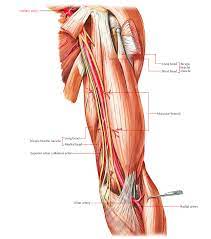
The arteries of the upper limb are an essential part of the circulatory system, supplying oxygen and nutrients to the muscles and tissues of the upper extremity. Understanding the anatomy and function of these arteries is crucial for healthcare professionals, including surgeons, cardiologists, and physiotherapists.
This article provides an overview of the arteries of the upper limb, including their origins, locations, functions, and clinical implications.
The brachial artery: origins, location, and function
The brachial artery is the major artery of the arm, supplying oxygen and nutrients to the arm muscles. It originates from the axillary artery, which arises from the subclavian artery in the neck. The brachial artery runs down the arm in the medial direction and terminates at the cubital fossa by bifurcating into the radial and ulnar arteries.
Anatomy of the brachial artery
The brachial artery is approximately 3-4 cm in length and has a diameter of 3-5 mm. It runs deep to the biceps brachii muscle and is covered by fascia and the medial head of the triceps muscle. The brachial artery is surrounded by numerous collateral vessels and lymph nodes.
Relations of the brachial artery
The brachial artery is closely related to several structures, including the median nerve, ulnar nerve, and basilic vein. The median nerve runs anteriorly to the brachial artery, while the ulnar nerve runs posteriorly to it. The basilic vein is a superficial vein that runs medially to the artery.
Branches of the brachial artery
The branches of the brachial artery include the radial and ulnar arteries, which supply the forearm. Other branches include the profunda brachii artery, superior ulnar collateral artery, and inferior ulnar collateral artery.
The radial artery: origins, location, and function
The radial artery is one of two major arteries of the forearm, supplying blood to the lateral aspect of the forearm and hand. It begins at the cubital fossa by branching off from the brachial artery and travels along the forearm, eventually moving towards the thumb side of the hand.
Anatomy of the radial artery
The radial artery is approximately 2.5 mm in diameter and has a more superficial location compared to the ulnar artery. It runs in the radial groove on the posterior aspect of the forearm, with the extensor carpi radialis longus muscle anteriorly and the brachioradialis muscle posteriorly.
Relations of the radial artery
The radial artery is closely related to the radial nerve, which travels with it in the radial groove. The artery is also related to the brachioradialis muscle and the radial collateral ligament of the wrist.
Branches of the radial artery
The branches of the radial artery include the radial recurrent artery, which supplies the elbow joint, and the palmar branches, which supply the hand. The deep palmar branch of the radial artery anastomoses with the ulnar artery to form the deep palmar arch.
The ulnar artery: origins, location, and function
The ulnar artery is the other major artery of the forearm, supplying blood to the medial aspect of the forearm and hand. It also originates from the brachial artery at the cubital fossa, running along the ulnar side of the forearm.
Anatomy of the ulnar artery
The ulnar artery is slightly larger than the radial artery, with a diameter of approximately 3 mm. It runs superficially to the flexor carpi ulnaris muscle in the ulnar groove.
Relations of the ulnar artery
The ulnar artery is closely related to the ulnar nerve, which travels with it along the forearm. The artery is also related to the flexor carpi ulnaris muscle and the ulnar collateral ligament of the wrist.
Branches of the ulnar artery
The branches of the ulnar artery include the common interosseous artery, which gives rise to the posterior interosseous artery and the anterior interosseous artery. The ulnar artery also gives rise to the palmar branches, which form the superficial and deep palmar arches in the hand.
The axillary artery: origins, location, and function
The axillary artery is the main artery of the shoulder, supplying oxygen and nutrients to the muscles and tissues of the region. It arises from the subclavian artery and runs through the axilla, terminating as the brachial artery.
Anatomy of the axillary artery
The axillary artery is approximately 6 cm in length and has a diameter of 6-8 mm. It is divided into three parts by the pectoralis minor muscle. The first part gives rise to the superior thoracic artery and the second part gives rise to several branches, including the thoracoacromial artery and the lateral thoracic artery.
Relations of the axillary artery
The axillary artery is related to several structures, including the brachial plexus, which provides innervation to the shoulder and upper limb. The artery is also related to the subscapular artery, which arises from the third part of the axillary artery and supplies the scapula and surrounding muscles.
Branches of the axillary artery
The branches of the axillary artery include the subscapular artery, anterior circumflex humeral artery, posterior circumflex humeral artery, and the thoracodorsal artery.
Common arterial injuries
Injury to the arteries of the upper limb may occur as a result of trauma or medical procedures, such as intravenous cannulation or arterial puncture. Common arterial injuries include brachial artery injuries, which may cause ischemia or even amputation of the limb. Radial and ulnar artery injuries may result in decreased blood flow to the hand, leading to ischemia and tissue damage.
Conditions affecting the arteries of the upper limb
Several conditions may affect the arteries of the upper limb, including thrombosis, aneurysms, and atherosclerosis. Thrombosis is the formation of a blood clot within a vessel, which may lead to occlusion of the vessel and tissue damage. Aneurysms are abnormal dilations of arteries that may lead to rupture and hemorrhage, while atherosclerosis is a condition where plaques develop within the walls of the arteries, leading to narrowing and decreased blood flow.
In conclusion, the arteries of the upper limb are important structures in the circulatory system, supplying oxygen and nutrients to the muscles and tissues of the upper extremity.
Understanding the anatomy and function of these arteries is crucial for healthcare professionals, and further research is needed to develop new treatments and interventions for conditions affecting the arteries of the upper limb. By improving our knowledge of the arteries of the upper limb, we can provide better care for patients and improve their overall health and well-being.






















